Contemporary Indigenous Health and Wellbeing Assessment
VerifiedAdded on 2022/08/17
|9
|2387
|16
AI Summary
Contribute Materials
Your contribution can guide someone’s learning journey. Share your
documents today.
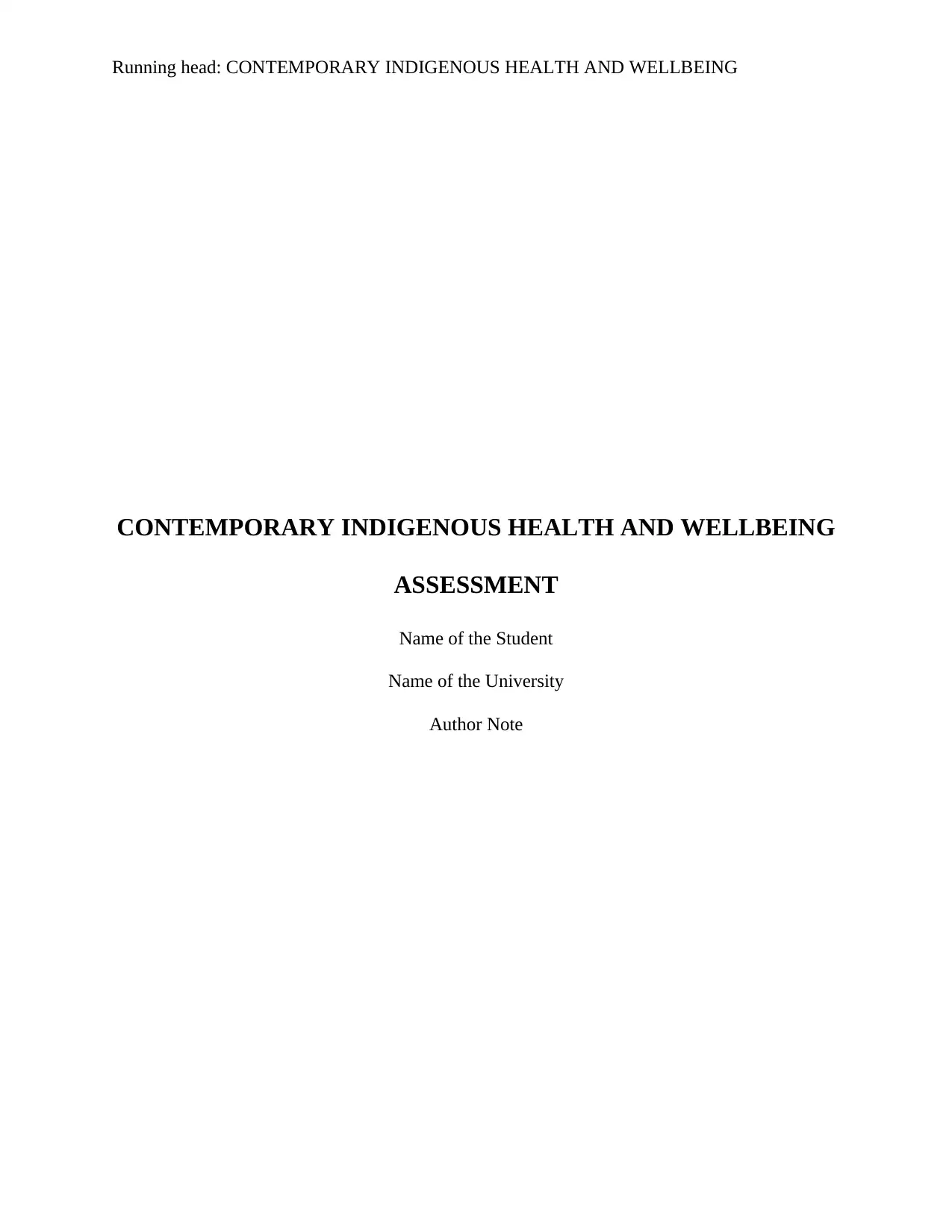
Running head: CONTEMPORARY INDIGENOUS HEALTH AND WELLBEING
CONTEMPORARY INDIGENOUS HEALTH AND WELLBEING
ASSESSMENT
Name of the Student
Name of the University
Author Note
CONTEMPORARY INDIGENOUS HEALTH AND WELLBEING
ASSESSMENT
Name of the Student
Name of the University
Author Note
Secure Best Marks with AI Grader
Need help grading? Try our AI Grader for instant feedback on your assignments.

1
CONTEMPORARY INDIGENOUS HEALTH AND WELLBEING ASSESSMENT
Section 1
Aboriginal people of Australia are the backward class due to the lack of knowledge,
socio-economic status and the population can be marked as minority as the number of people is
very low. The health care framework that is present in Australia is actually comprised of
discriminative behaviour towards aboriginal people. Hence, the attitude of the health care
workers should be changed regarding the health care delivery to the Aboriginal people. Based on
this factor in the following section I will develop a reflection regarding the behavioural change
processes towards the Aboriginal people of the country from the health care workers.
Section 2
Activity 1:
As most other people I also have a stereotypical attitude towards the aboriginal people
that is the discriminative approach towards them. However, attending the classes and the recent
studies I have understood the life struggle of the Aboriginal people. I have found that the people
from this community have been discriminated from others and also they do not have the
knowledge or the access to the health care facilities (Paternotte et al. 2017). Hence, it can be
started that the racism of White people lead to this condition and left them vulnerable to the
negative health other social factors. Based on this conceptual knowledge development and the
analysis of the situation I have identified some critical behavioural approach that affect the health
care process of the people from the Aboriginal community (Durey et al. 2016). Hence, I can
reflect that the change in the situation should be considered for the improvement of the health
condition of these people. It has been seen that the Aboriginal people has a lower life expectancy
rate that is 71.6 and 75.6 for the males and females respectively (Abs.gov.au, 2018). It can also
CONTEMPORARY INDIGENOUS HEALTH AND WELLBEING ASSESSMENT
Section 1
Aboriginal people of Australia are the backward class due to the lack of knowledge,
socio-economic status and the population can be marked as minority as the number of people is
very low. The health care framework that is present in Australia is actually comprised of
discriminative behaviour towards aboriginal people. Hence, the attitude of the health care
workers should be changed regarding the health care delivery to the Aboriginal people. Based on
this factor in the following section I will develop a reflection regarding the behavioural change
processes towards the Aboriginal people of the country from the health care workers.
Section 2
Activity 1:
As most other people I also have a stereotypical attitude towards the aboriginal people
that is the discriminative approach towards them. However, attending the classes and the recent
studies I have understood the life struggle of the Aboriginal people. I have found that the people
from this community have been discriminated from others and also they do not have the
knowledge or the access to the health care facilities (Paternotte et al. 2017). Hence, it can be
started that the racism of White people lead to this condition and left them vulnerable to the
negative health other social factors. Based on this conceptual knowledge development and the
analysis of the situation I have identified some critical behavioural approach that affect the health
care process of the people from the Aboriginal community (Durey et al. 2016). Hence, I can
reflect that the change in the situation should be considered for the improvement of the health
condition of these people. It has been seen that the Aboriginal people has a lower life expectancy
rate that is 71.6 and 75.6 for the males and females respectively (Abs.gov.au, 2018). It can also
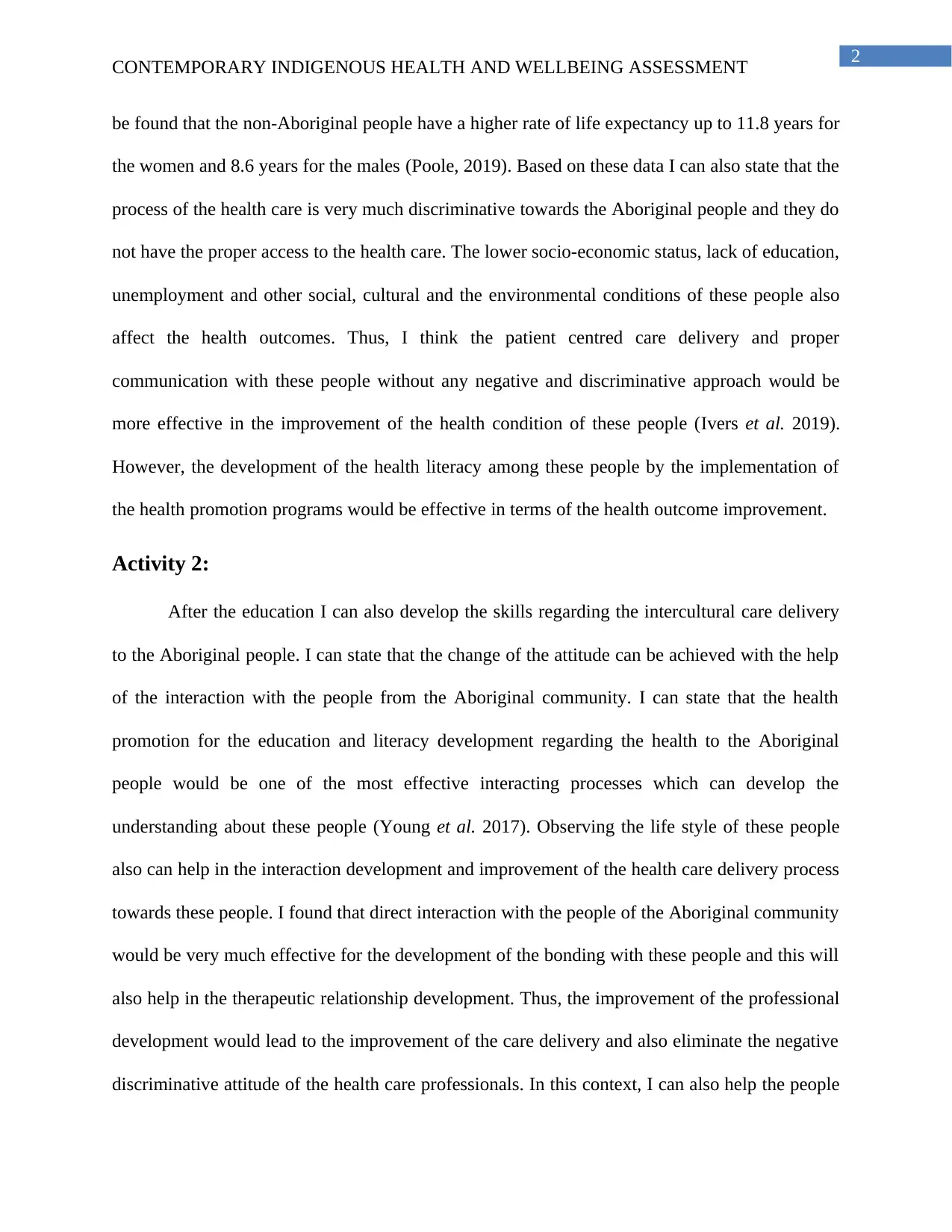
2
CONTEMPORARY INDIGENOUS HEALTH AND WELLBEING ASSESSMENT
be found that the non-Aboriginal people have a higher rate of life expectancy up to 11.8 years for
the women and 8.6 years for the males (Poole, 2019). Based on these data I can also state that the
process of the health care is very much discriminative towards the Aboriginal people and they do
not have the proper access to the health care. The lower socio-economic status, lack of education,
unemployment and other social, cultural and the environmental conditions of these people also
affect the health outcomes. Thus, I think the patient centred care delivery and proper
communication with these people without any negative and discriminative approach would be
more effective in the improvement of the health condition of these people (Ivers et al. 2019).
However, the development of the health literacy among these people by the implementation of
the health promotion programs would be effective in terms of the health outcome improvement.
Activity 2:
After the education I can also develop the skills regarding the intercultural care delivery
to the Aboriginal people. I can state that the change of the attitude can be achieved with the help
of the interaction with the people from the Aboriginal community. I can state that the health
promotion for the education and literacy development regarding the health to the Aboriginal
people would be one of the most effective interacting processes which can develop the
understanding about these people (Young et al. 2017). Observing the life style of these people
also can help in the interaction development and improvement of the health care delivery process
towards these people. I found that direct interaction with the people of the Aboriginal community
would be very much effective for the development of the bonding with these people and this will
also help in the therapeutic relationship development. Thus, the improvement of the professional
development would lead to the improvement of the care delivery and also eliminate the negative
discriminative attitude of the health care professionals. In this context, I can also help the people
CONTEMPORARY INDIGENOUS HEALTH AND WELLBEING ASSESSMENT
be found that the non-Aboriginal people have a higher rate of life expectancy up to 11.8 years for
the women and 8.6 years for the males (Poole, 2019). Based on these data I can also state that the
process of the health care is very much discriminative towards the Aboriginal people and they do
not have the proper access to the health care. The lower socio-economic status, lack of education,
unemployment and other social, cultural and the environmental conditions of these people also
affect the health outcomes. Thus, I think the patient centred care delivery and proper
communication with these people without any negative and discriminative approach would be
more effective in the improvement of the health condition of these people (Ivers et al. 2019).
However, the development of the health literacy among these people by the implementation of
the health promotion programs would be effective in terms of the health outcome improvement.
Activity 2:
After the education I can also develop the skills regarding the intercultural care delivery
to the Aboriginal people. I can state that the change of the attitude can be achieved with the help
of the interaction with the people from the Aboriginal community. I can state that the health
promotion for the education and literacy development regarding the health to the Aboriginal
people would be one of the most effective interacting processes which can develop the
understanding about these people (Young et al. 2017). Observing the life style of these people
also can help in the interaction development and improvement of the health care delivery process
towards these people. I found that direct interaction with the people of the Aboriginal community
would be very much effective for the development of the bonding with these people and this will
also help in the therapeutic relationship development. Thus, the improvement of the professional
development would lead to the improvement of the care delivery and also eliminate the negative
discriminative attitude of the health care professionals. In this context, I can also help the people
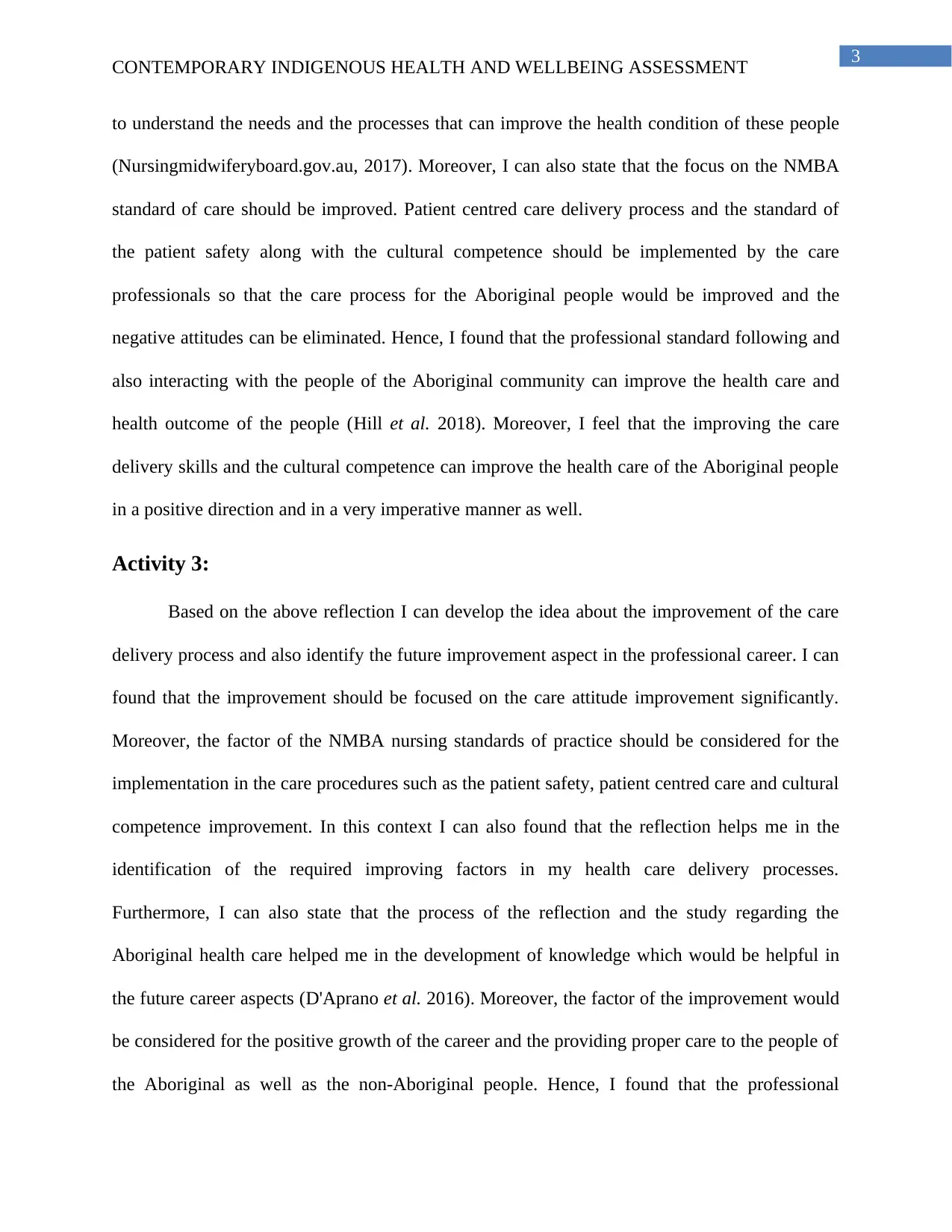
3
CONTEMPORARY INDIGENOUS HEALTH AND WELLBEING ASSESSMENT
to understand the needs and the processes that can improve the health condition of these people
(Nursingmidwiferyboard.gov.au, 2017). Moreover, I can also state that the focus on the NMBA
standard of care should be improved. Patient centred care delivery process and the standard of
the patient safety along with the cultural competence should be implemented by the care
professionals so that the care process for the Aboriginal people would be improved and the
negative attitudes can be eliminated. Hence, I found that the professional standard following and
also interacting with the people of the Aboriginal community can improve the health care and
health outcome of the people (Hill et al. 2018). Moreover, I feel that the improving the care
delivery skills and the cultural competence can improve the health care of the Aboriginal people
in a positive direction and in a very imperative manner as well.
Activity 3:
Based on the above reflection I can develop the idea about the improvement of the care
delivery process and also identify the future improvement aspect in the professional career. I can
found that the improvement should be focused on the care attitude improvement significantly.
Moreover, the factor of the NMBA nursing standards of practice should be considered for the
implementation in the care procedures such as the patient safety, patient centred care and cultural
competence improvement. In this context I can also found that the reflection helps me in the
identification of the required improving factors in my health care delivery processes.
Furthermore, I can also state that the process of the reflection and the study regarding the
Aboriginal health care helped me in the development of knowledge which would be helpful in
the future career aspects (D'Aprano et al. 2016). Moreover, the factor of the improvement would
be considered for the positive growth of the career and the providing proper care to the people of
the Aboriginal as well as the non-Aboriginal people. Hence, I found that the professional
CONTEMPORARY INDIGENOUS HEALTH AND WELLBEING ASSESSMENT
to understand the needs and the processes that can improve the health condition of these people
(Nursingmidwiferyboard.gov.au, 2017). Moreover, I can also state that the focus on the NMBA
standard of care should be improved. Patient centred care delivery process and the standard of
the patient safety along with the cultural competence should be implemented by the care
professionals so that the care process for the Aboriginal people would be improved and the
negative attitudes can be eliminated. Hence, I found that the professional standard following and
also interacting with the people of the Aboriginal community can improve the health care and
health outcome of the people (Hill et al. 2018). Moreover, I feel that the improving the care
delivery skills and the cultural competence can improve the health care of the Aboriginal people
in a positive direction and in a very imperative manner as well.
Activity 3:
Based on the above reflection I can develop the idea about the improvement of the care
delivery process and also identify the future improvement aspect in the professional career. I can
found that the improvement should be focused on the care attitude improvement significantly.
Moreover, the factor of the NMBA nursing standards of practice should be considered for the
implementation in the care procedures such as the patient safety, patient centred care and cultural
competence improvement. In this context I can also found that the reflection helps me in the
identification of the required improving factors in my health care delivery processes.
Furthermore, I can also state that the process of the reflection and the study regarding the
Aboriginal health care helped me in the development of knowledge which would be helpful in
the future career aspects (D'Aprano et al. 2016). Moreover, the factor of the improvement would
be considered for the positive growth of the career and the providing proper care to the people of
the Aboriginal as well as the non-Aboriginal people. Hence, I found that the professional
Secure Best Marks with AI Grader
Need help grading? Try our AI Grader for instant feedback on your assignments.
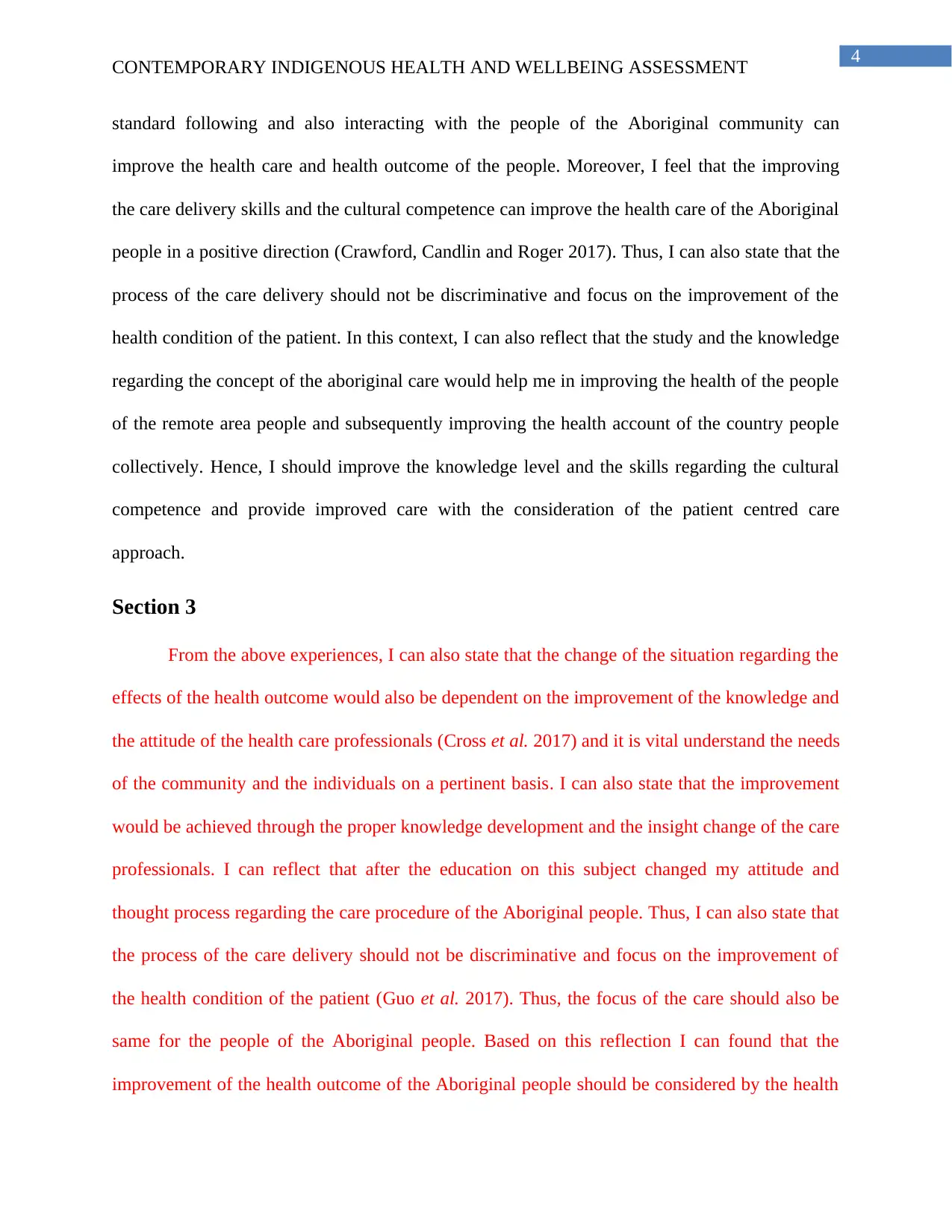
4
CONTEMPORARY INDIGENOUS HEALTH AND WELLBEING ASSESSMENT
standard following and also interacting with the people of the Aboriginal community can
improve the health care and health outcome of the people. Moreover, I feel that the improving
the care delivery skills and the cultural competence can improve the health care of the Aboriginal
people in a positive direction (Crawford, Candlin and Roger 2017). Thus, I can also state that the
process of the care delivery should not be discriminative and focus on the improvement of the
health condition of the patient. In this context, I can also reflect that the study and the knowledge
regarding the concept of the aboriginal care would help me in improving the health of the people
of the remote area people and subsequently improving the health account of the country people
collectively. Hence, I should improve the knowledge level and the skills regarding the cultural
competence and provide improved care with the consideration of the patient centred care
approach.
Section 3
From the above experiences, I can also state that the change of the situation regarding the
effects of the health outcome would also be dependent on the improvement of the knowledge and
the attitude of the health care professionals (Cross et al. 2017) and it is vital understand the needs
of the community and the individuals on a pertinent basis. I can also state that the improvement
would be achieved through the proper knowledge development and the insight change of the care
professionals. I can reflect that after the education on this subject changed my attitude and
thought process regarding the care procedure of the Aboriginal people. Thus, I can also state that
the process of the care delivery should not be discriminative and focus on the improvement of
the health condition of the patient (Guo et al. 2017). Thus, the focus of the care should also be
same for the people of the Aboriginal people. Based on this reflection I can found that the
improvement of the health outcome of the Aboriginal people should be considered by the health
CONTEMPORARY INDIGENOUS HEALTH AND WELLBEING ASSESSMENT
standard following and also interacting with the people of the Aboriginal community can
improve the health care and health outcome of the people. Moreover, I feel that the improving
the care delivery skills and the cultural competence can improve the health care of the Aboriginal
people in a positive direction (Crawford, Candlin and Roger 2017). Thus, I can also state that the
process of the care delivery should not be discriminative and focus on the improvement of the
health condition of the patient. In this context, I can also reflect that the study and the knowledge
regarding the concept of the aboriginal care would help me in improving the health of the people
of the remote area people and subsequently improving the health account of the country people
collectively. Hence, I should improve the knowledge level and the skills regarding the cultural
competence and provide improved care with the consideration of the patient centred care
approach.
Section 3
From the above experiences, I can also state that the change of the situation regarding the
effects of the health outcome would also be dependent on the improvement of the knowledge and
the attitude of the health care professionals (Cross et al. 2017) and it is vital understand the needs
of the community and the individuals on a pertinent basis. I can also state that the improvement
would be achieved through the proper knowledge development and the insight change of the care
professionals. I can reflect that after the education on this subject changed my attitude and
thought process regarding the care procedure of the Aboriginal people. Thus, I can also state that
the process of the care delivery should not be discriminative and focus on the improvement of
the health condition of the patient (Guo et al. 2017). Thus, the focus of the care should also be
same for the people of the Aboriginal people. Based on this reflection I can found that the
improvement of the health outcome of the Aboriginal people should be considered by the health
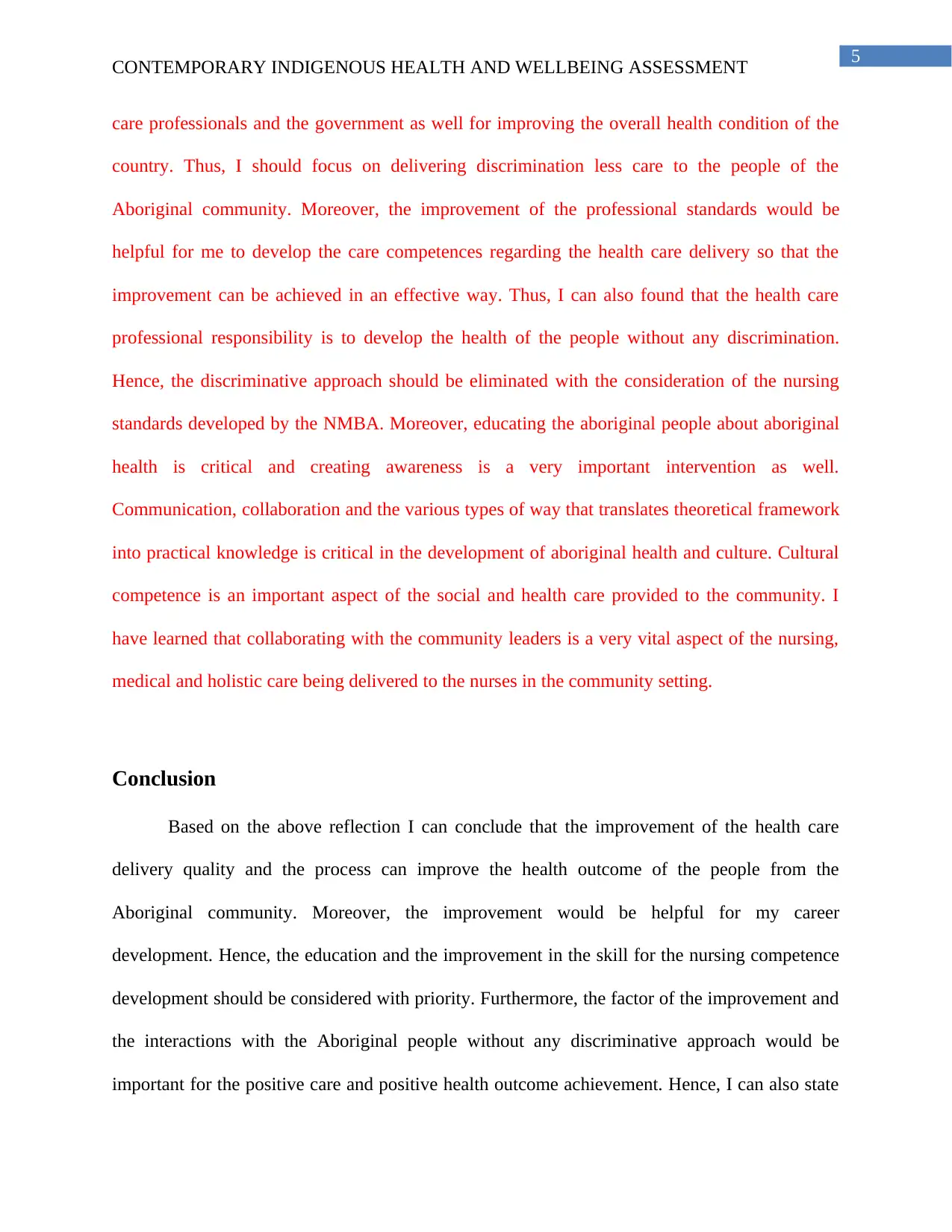
5
CONTEMPORARY INDIGENOUS HEALTH AND WELLBEING ASSESSMENT
care professionals and the government as well for improving the overall health condition of the
country. Thus, I should focus on delivering discrimination less care to the people of the
Aboriginal community. Moreover, the improvement of the professional standards would be
helpful for me to develop the care competences regarding the health care delivery so that the
improvement can be achieved in an effective way. Thus, I can also found that the health care
professional responsibility is to develop the health of the people without any discrimination.
Hence, the discriminative approach should be eliminated with the consideration of the nursing
standards developed by the NMBA. Moreover, educating the aboriginal people about aboriginal
health is critical and creating awareness is a very important intervention as well.
Communication, collaboration and the various types of way that translates theoretical framework
into practical knowledge is critical in the development of aboriginal health and culture. Cultural
competence is an important aspect of the social and health care provided to the community. I
have learned that collaborating with the community leaders is a very vital aspect of the nursing,
medical and holistic care being delivered to the nurses in the community setting.
Conclusion
Based on the above reflection I can conclude that the improvement of the health care
delivery quality and the process can improve the health outcome of the people from the
Aboriginal community. Moreover, the improvement would be helpful for my career
development. Hence, the education and the improvement in the skill for the nursing competence
development should be considered with priority. Furthermore, the factor of the improvement and
the interactions with the Aboriginal people without any discriminative approach would be
important for the positive care and positive health outcome achievement. Hence, I can also state
CONTEMPORARY INDIGENOUS HEALTH AND WELLBEING ASSESSMENT
care professionals and the government as well for improving the overall health condition of the
country. Thus, I should focus on delivering discrimination less care to the people of the
Aboriginal community. Moreover, the improvement of the professional standards would be
helpful for me to develop the care competences regarding the health care delivery so that the
improvement can be achieved in an effective way. Thus, I can also found that the health care
professional responsibility is to develop the health of the people without any discrimination.
Hence, the discriminative approach should be eliminated with the consideration of the nursing
standards developed by the NMBA. Moreover, educating the aboriginal people about aboriginal
health is critical and creating awareness is a very important intervention as well.
Communication, collaboration and the various types of way that translates theoretical framework
into practical knowledge is critical in the development of aboriginal health and culture. Cultural
competence is an important aspect of the social and health care provided to the community. I
have learned that collaborating with the community leaders is a very vital aspect of the nursing,
medical and holistic care being delivered to the nurses in the community setting.
Conclusion
Based on the above reflection I can conclude that the improvement of the health care
delivery quality and the process can improve the health outcome of the people from the
Aboriginal community. Moreover, the improvement would be helpful for my career
development. Hence, the education and the improvement in the skill for the nursing competence
development should be considered with priority. Furthermore, the factor of the improvement and
the interactions with the Aboriginal people without any discriminative approach would be
important for the positive care and positive health outcome achievement. Hence, I can also state

6
CONTEMPORARY INDIGENOUS HEALTH AND WELLBEING ASSESSMENT
that the interaction with the people of the Aboriginal community can help me understanding the
needs of these people. Hence, it is critical that the various aspects of the nursing care is delivered
with effective cultural communication, professional competence that is through the appropriate
demonstration of nursing principles and skills. Indigenous cultural respect is an important aspect
of the care.
CONTEMPORARY INDIGENOUS HEALTH AND WELLBEING ASSESSMENT
that the interaction with the people of the Aboriginal community can help me understanding the
needs of these people. Hence, it is critical that the various aspects of the nursing care is delivered
with effective cultural communication, professional competence that is through the appropriate
demonstration of nursing principles and skills. Indigenous cultural respect is an important aspect
of the care.
Paraphrase This Document
Need a fresh take? Get an instant paraphrase of this document with our AI Paraphraser
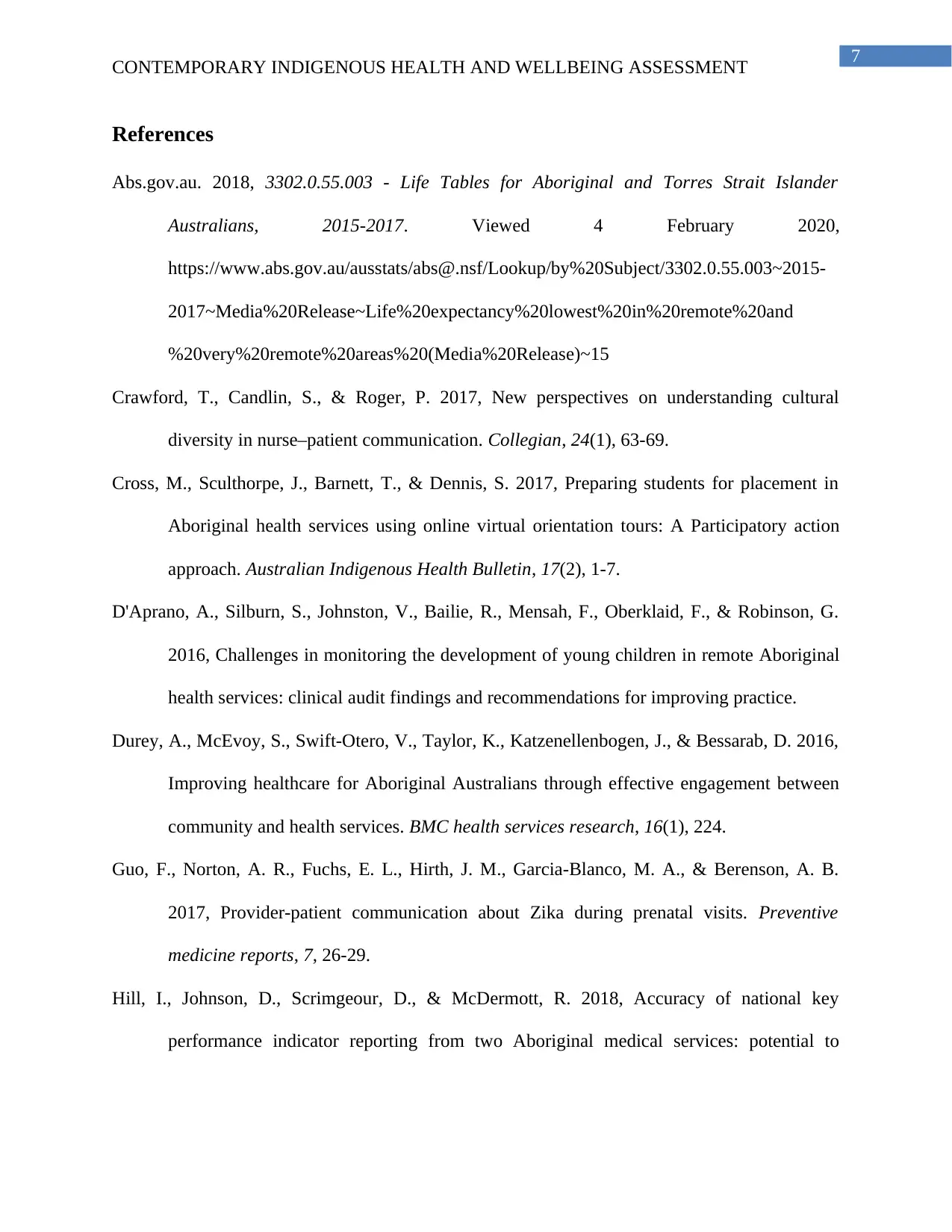
7
CONTEMPORARY INDIGENOUS HEALTH AND WELLBEING ASSESSMENT
References
Abs.gov.au. 2018, 3302.0.55.003 - Life Tables for Aboriginal and Torres Strait Islander
Australians, 2015-2017. Viewed 4 February 2020,
https://www.abs.gov.au/ausstats/abs@.nsf/Lookup/by%20Subject/3302.0.55.003~2015-
2017~Media%20Release~Life%20expectancy%20lowest%20in%20remote%20and
%20very%20remote%20areas%20(Media%20Release)~15
Crawford, T., Candlin, S., & Roger, P. 2017, New perspectives on understanding cultural
diversity in nurse–patient communication. Collegian, 24(1), 63-69.
Cross, M., Sculthorpe, J., Barnett, T., & Dennis, S. 2017, Preparing students for placement in
Aboriginal health services using online virtual orientation tours: A Participatory action
approach. Australian Indigenous Health Bulletin, 17(2), 1-7.
D'Aprano, A., Silburn, S., Johnston, V., Bailie, R., Mensah, F., Oberklaid, F., & Robinson, G.
2016, Challenges in monitoring the development of young children in remote Aboriginal
health services: clinical audit findings and recommendations for improving practice.
Durey, A., McEvoy, S., Swift-Otero, V., Taylor, K., Katzenellenbogen, J., & Bessarab, D. 2016,
Improving healthcare for Aboriginal Australians through effective engagement between
community and health services. BMC health services research, 16(1), 224.
Guo, F., Norton, A. R., Fuchs, E. L., Hirth, J. M., Garcia-Blanco, M. A., & Berenson, A. B.
2017, Provider-patient communication about Zika during prenatal visits. Preventive
medicine reports, 7, 26-29.
Hill, I., Johnson, D., Scrimgeour, D., & McDermott, R. 2018, Accuracy of national key
performance indicator reporting from two Aboriginal medical services: potential to
CONTEMPORARY INDIGENOUS HEALTH AND WELLBEING ASSESSMENT
References
Abs.gov.au. 2018, 3302.0.55.003 - Life Tables for Aboriginal and Torres Strait Islander
Australians, 2015-2017. Viewed 4 February 2020,
https://www.abs.gov.au/ausstats/abs@.nsf/Lookup/by%20Subject/3302.0.55.003~2015-
2017~Media%20Release~Life%20expectancy%20lowest%20in%20remote%20and
%20very%20remote%20areas%20(Media%20Release)~15
Crawford, T., Candlin, S., & Roger, P. 2017, New perspectives on understanding cultural
diversity in nurse–patient communication. Collegian, 24(1), 63-69.
Cross, M., Sculthorpe, J., Barnett, T., & Dennis, S. 2017, Preparing students for placement in
Aboriginal health services using online virtual orientation tours: A Participatory action
approach. Australian Indigenous Health Bulletin, 17(2), 1-7.
D'Aprano, A., Silburn, S., Johnston, V., Bailie, R., Mensah, F., Oberklaid, F., & Robinson, G.
2016, Challenges in monitoring the development of young children in remote Aboriginal
health services: clinical audit findings and recommendations for improving practice.
Durey, A., McEvoy, S., Swift-Otero, V., Taylor, K., Katzenellenbogen, J., & Bessarab, D. 2016,
Improving healthcare for Aboriginal Australians through effective engagement between
community and health services. BMC health services research, 16(1), 224.
Guo, F., Norton, A. R., Fuchs, E. L., Hirth, J. M., Garcia-Blanco, M. A., & Berenson, A. B.
2017, Provider-patient communication about Zika during prenatal visits. Preventive
medicine reports, 7, 26-29.
Hill, I., Johnson, D., Scrimgeour, D., & McDermott, R. 2018, Accuracy of national key
performance indicator reporting from two Aboriginal medical services: potential to
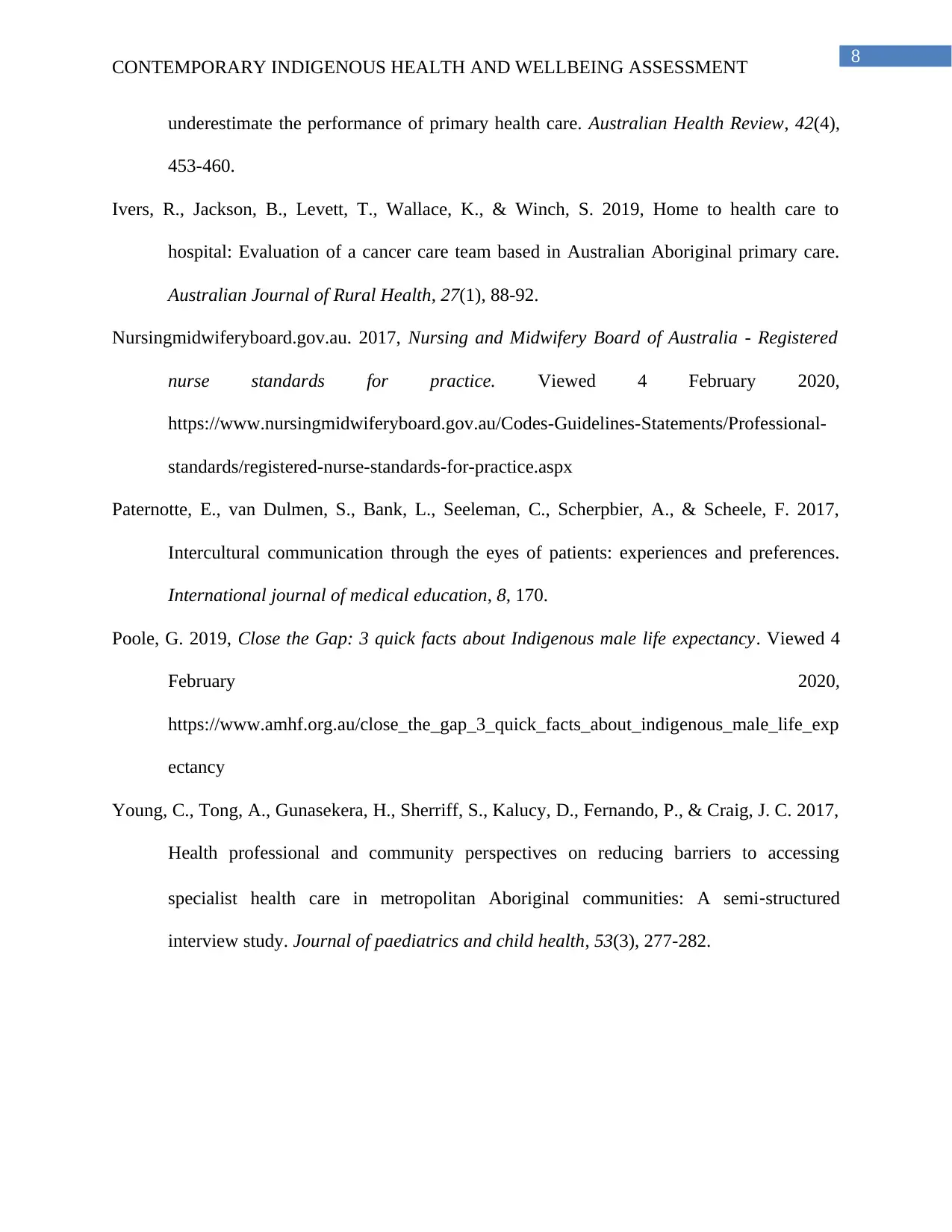
8
CONTEMPORARY INDIGENOUS HEALTH AND WELLBEING ASSESSMENT
underestimate the performance of primary health care. Australian Health Review, 42(4),
453-460.
Ivers, R., Jackson, B., Levett, T., Wallace, K., & Winch, S. 2019, Home to health care to
hospital: Evaluation of a cancer care team based in Australian Aboriginal primary care.
Australian Journal of Rural Health, 27(1), 88-92.
Nursingmidwiferyboard.gov.au. 2017, Nursing and Midwifery Board of Australia - Registered
nurse standards for practice. Viewed 4 February 2020,
https://www.nursingmidwiferyboard.gov.au/Codes-Guidelines-Statements/Professional-
standards/registered-nurse-standards-for-practice.aspx
Paternotte, E., van Dulmen, S., Bank, L., Seeleman, C., Scherpbier, A., & Scheele, F. 2017,
Intercultural communication through the eyes of patients: experiences and preferences.
International journal of medical education, 8, 170.
Poole, G. 2019, Close the Gap: 3 quick facts about Indigenous male life expectancy. Viewed 4
February 2020,
https://www.amhf.org.au/close_the_gap_3_quick_facts_about_indigenous_male_life_exp
ectancy
Young, C., Tong, A., Gunasekera, H., Sherriff, S., Kalucy, D., Fernando, P., & Craig, J. C. 2017,
Health professional and community perspectives on reducing barriers to accessing
specialist health care in metropolitan Aboriginal communities: A semi‐structured
interview study. Journal of paediatrics and child health, 53(3), 277-282.
CONTEMPORARY INDIGENOUS HEALTH AND WELLBEING ASSESSMENT
underestimate the performance of primary health care. Australian Health Review, 42(4),
453-460.
Ivers, R., Jackson, B., Levett, T., Wallace, K., & Winch, S. 2019, Home to health care to
hospital: Evaluation of a cancer care team based in Australian Aboriginal primary care.
Australian Journal of Rural Health, 27(1), 88-92.
Nursingmidwiferyboard.gov.au. 2017, Nursing and Midwifery Board of Australia - Registered
nurse standards for practice. Viewed 4 February 2020,
https://www.nursingmidwiferyboard.gov.au/Codes-Guidelines-Statements/Professional-
standards/registered-nurse-standards-for-practice.aspx
Paternotte, E., van Dulmen, S., Bank, L., Seeleman, C., Scherpbier, A., & Scheele, F. 2017,
Intercultural communication through the eyes of patients: experiences and preferences.
International journal of medical education, 8, 170.
Poole, G. 2019, Close the Gap: 3 quick facts about Indigenous male life expectancy. Viewed 4
February 2020,
https://www.amhf.org.au/close_the_gap_3_quick_facts_about_indigenous_male_life_exp
ectancy
Young, C., Tong, A., Gunasekera, H., Sherriff, S., Kalucy, D., Fernando, P., & Craig, J. C. 2017,
Health professional and community perspectives on reducing barriers to accessing
specialist health care in metropolitan Aboriginal communities: A semi‐structured
interview study. Journal of paediatrics and child health, 53(3), 277-282.
1 out of 9
Related Documents
Your All-in-One AI-Powered Toolkit for Academic Success.
+13062052269
info@desklib.com
Available 24*7 on WhatsApp / Email
![[object Object]](/_next/static/media/star-bottom.7253800d.svg)
Unlock your academic potential
© 2024 | Zucol Services PVT LTD | All rights reserved.





